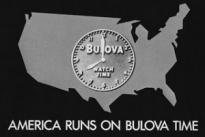Blame it on Bulova: Commercial Television turns 70!
July 1, 1941: the beginning of life as we know it. Commercial television made its debut in the United States.
 Over the next few years, television programs and personalities would become closely identified with their commercial sponsors, some shows even featuring their backer within the title, as in Milton Berle’s Texaco Star Theater. Jack Benny would forever become associated with J-E-L-L-O, and those who loved George Burns and Gracie Allen may still have a special fondness for Carnation milk. Product placement, integrated commercials, and what has come to be known as participating sponsorship (multiple sponsors for one program) still dominate the airwaves. But on that fateful July day, which corporate behemoth snagged America’s first TV commercial? None other than Bulova.
Over the next few years, television programs and personalities would become closely identified with their commercial sponsors, some shows even featuring their backer within the title, as in Milton Berle’s Texaco Star Theater. Jack Benny would forever become associated with J-E-L-L-O, and those who loved George Burns and Gracie Allen may still have a special fondness for Carnation milk. Product placement, integrated commercials, and what has come to be known as participating sponsorship (multiple sponsors for one program) still dominate the airwaves. But on that fateful July day, which corporate behemoth snagged America’s first TV commercial? None other than Bulova.
You're probably picturing something like this: a woman with perfectly coiffed hair showcasing a swanky Bulova watch, Vanna White-style, as a male voiceover touts the product’s virtues. Of course, that’s not even close to what the few thousand people watching television that day saw. Instead, they witnessed a ticking nondescript Bulova clock laid over a map of the United States, with the slogan “America Runs on Bulova Time” placed below. The ad ran at the start of the Philadelphia Phillies/Brooklyn Dodgers game. The amount Bulova paid for the advertisement? A mere $9.
Archive interviewee Ray Forrest narrated that first ad, as he recalls in this interview excerpt:
Additional programming on July 1 consisted of Lowell Thomas reading the news on NBC, Ralph Edwards hosting Ivory Soap’s Truth or Consequences, and several other game and quiz shows including one called Uncle Jim’s Question Bee. Since all television was live at the time, no visual footage remains of these initial broadcasts, but the NBC Archives does contain audio recordings of those historic broadcasts.
Although we will never get to see those first commercial broadcasts, their legacy is evident every time we turn on the tube. Over the past 70 years, we’ve learned to fast-forward through commercials, mute them, or take bathroom or snack breaks while they air, but with the exception of public broadcasting (which itself has “brought to you by” spots that bear a striking resemblance to advertisements), television and commercials go together like peas and carrots. Unless we’re premium cable subscribers, ad-sponsored television is largely the only kind most of us have ever known.
Nowadays, DVRs, along with Internet and mobile programming, have thrown a wrench into the traditional structure. Seventy years ago the networks faced the dilemma of how to make the new medium of television a lucrative venture, and today they again struggle with how to sustain profits amid burgeoning technology. Commercials provided the solution decades ago, but will they still do so today? Texaco, J-E-L-L-O, Carnation, and (yes) Bulova are still around, and I’m betting commercials won’t entirely go the way of Uncle Jim’s Question Bee.
Happy 70th anniversary, commercial television. Can’t wait to see what you’re like at your 100th.
- Adrienne Faillace
The Archive of American Television celebrates this historic day with a selection of clips from interviewees talking about commercials they appeared in, below.
Walter Cronkite on the only commercial he ever did (for Winston cigarettes):
Florence Henderson on her Wesson ads:
Michael J. Fox on pitching Pepsi:
Writer Allan Burns on coming up with the "Cap 'n Crunch" logo and ad:
For more on this topic, visit the Archive's "Commercials" television genre page at http://emmytvlegends.org/interviews/shows/commercials
